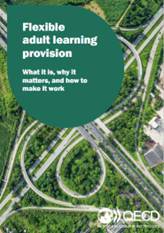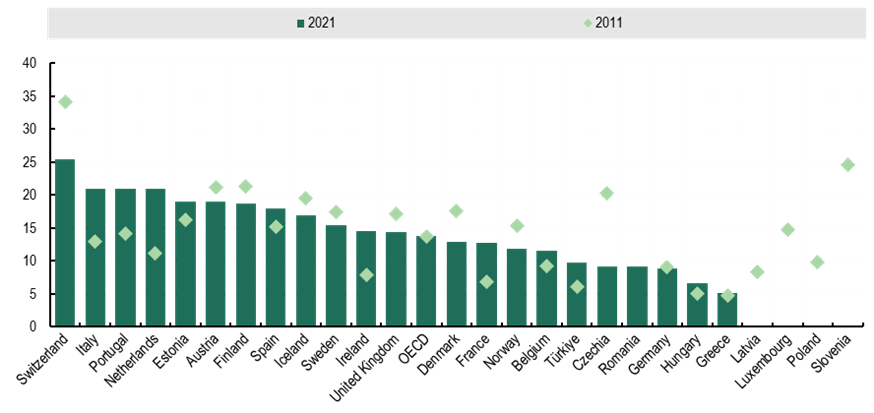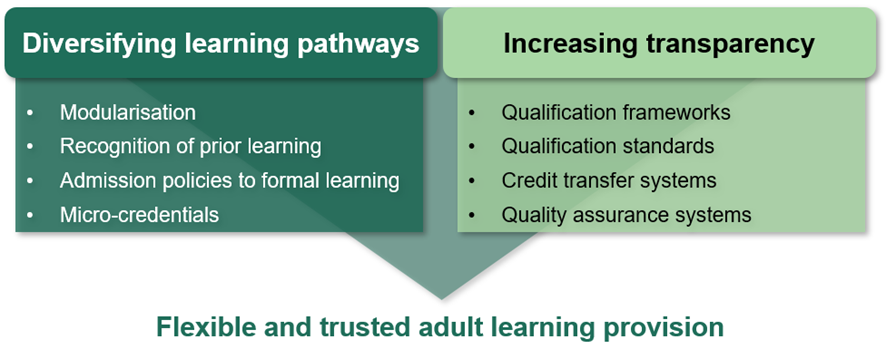By Anja Meierkord and Elif Bahar

Flexible provision of adult learning is essential for individuals, enterprises, and societies to adapt to labour market changes. It increases choice for learners and improves the capacity of labour markets to respond to structural change. The new OECD brief flexible adult learning provision: What it is, why it matters and how to make it work provides a framework for thinking about flexibility and discusses policy options for increasing flexibility of adult learning provision.
How we work, where we work and what we work on is changing, driven by global trends such as digitalisation, the green transition, and an ageing population. Adult learning systems are essential to help individuals, enterprises, and societies keep pace with these changes. Hence, policy makers everywhere are working to make adult learning systems more effective, inclusive, and responsive to current and future skills challenges. Increasing the flexibility of adult learning provision to meet the needs of diverse learners is a key aspect of this.
Why do we need more flexible provision?
Investing in skills is one of the main responses to the challenges posed by structural change. As most people affected by this change are already in the labour market, adult learning has a key role to play in raising the skill levels of individuals and populations. However, many countries are struggling to increase participation in adult learning, in general, and to close the participation gap between more and less advantaged groups.
Figure 1. The participation gap between low-skilled and high-skilled adults remains large

Note: The data refer to the percentage point difference in learning participation of low- and high-skilled adults and to participation in formal and non-formal learning in the 4 weeks preceding the survey.; Low skilled = ISCED 0-2, high-skilled: ISCED 5-8. OECD average = unweighted average of the countries shown. Source: European Labour Force Survey data.
This lack of progress is explained by the fact that many adults face multiple, multifaceted, and interrelated barriers to participation in learning, which are difficult to address through a single policy intervention. These include dispositional barriers, such as concerns about ability to succeed; situational barriers, such as lack of time due to caring responsibilities or an inconvenient place of training; and institutional barriers, such as a lack of learning opportunities tailored to specific needs. Low-skilled adults tend to face a greater number of barriers on average than those with higher skills.Adult learning systems need to do better for those currently least likely to participate in education and training. The lack of progress in closing participation gaps and the persistence of barriers to participation highlight the need for systematic reform of adult learning systems. In particular, greater individual choice and more flexible adult learning provision are needed.
What is flexible adult learning provision?
Many adult learning systems today are stuck in rigid traditional structures with set schedules, classroom- based learning, and fixed learning speeds. However, there is a growing trend towards more flexible learning, which allows individuals to choose when and where they learn, how they learn, and what they learn, making it easier to balance education, training, work and life. As lack of time is one of the main barriers to learning, offering learners a variety of options to vary their study load – for example, by studying part-time, attending courses on weekends, or incorporating asynchronous learning (i.e., a situation in which the instructor and the learner(s) are not interacting with each other in real time) into curricula – can improve access to learning. Similarly, enabling adults to learn in a place that suits them through distance, online and work-based learning options, can remove a major barrier to participation in learning. Offering a variety of learning modes, including face-to-face, online, hybrid and blended learning, accommodates learners with preferences for different learning styles. Finally, enabling adults to create individual learning experiences that meet their needs can be made possible through modularisation as well as advances in learning analytics, driven in particular by artificial intelligence.
Figure 2. There are four main ways in which adult learning provision can offer greater flexibility

What can policy makers do?
Policy makers have several tools at their disposal to increase the flexibility of adult learning provision along the dimensions outlined above. They can introduce regulations related to the time dimension, requiring education and training providers to offer evening classes, for example. Or they can provide financial incentives to encourage the development of certain modes of learning, such as online and blended learning options for on-demand skills.However, policy makers also need to consider deeper structural changes to increase flexibility in their adult learning provision. These can be divided into two categories. First, there are policies that adapt learning opportunities to individual needs, such as the recognition of prior learning, modularisation (i.e. breaking down a learning programme into discrete parts), flexible admissions policies, and micro-credentials. Second, there are policies that aim to increase transparency in the adult learning system, including national qualifications frameworks, credit systems and quality assurance mechanisms. It is essential that these policies work together to create flexible learning opportunities that are trusted by individuals, employers and learning providers.
Figure 3. Increasing flexibility of and trust in adult learning provision must go hand-in-hand

What next?
Find out more about the different policy options and read about good practices implemented across the OECD area here.
